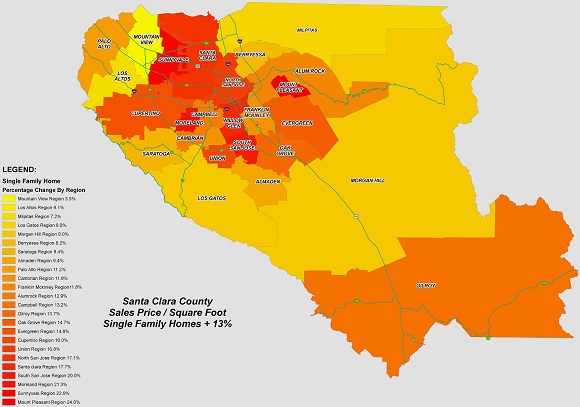Assessor Larry Stone releases critical residential market data
 Earlier today Santa Clara County Assessor Larry Stone released detailed market data for single family and condominiums over the past two years. The data is broken down by 25 neighborhoods, primarily following elementary school district boundaries. The information is an important, early indicator of the positive direction of the housing market, in every geographic area of the County, and is being used by the Assessor’s office in the assessment of residential property scheduled for release at the end of June.
Earlier today Santa Clara County Assessor Larry Stone released detailed market data for single family and condominiums over the past two years. The data is broken down by 25 neighborhoods, primarily following elementary school district boundaries. The information is an important, early indicator of the positive direction of the housing market, in every geographic area of the County, and is being used by the Assessor’s office in the assessment of residential property scheduled for release at the end of June.
“The information is great news for property owners whose home is likely their single most valuable asset. A significant increase in homeowner equity is always welcome news,” said Assessor Larry Stone. “Property owners who received temporary reductions in assessed values in prior years to reflect declining market values, will likely experience corresponding increases in property taxes to reflect improvement in market values,” said Stone. However, for most property owners their assessed value will increase by no more than the maximum of 2 percent, the same amount as in prior years, in accordance with the California Consumer Price Index limit prescribed by Proposition 13. “During the Great Recession all property owners experienced reductions in homeowner equity, but only a quarter of property owners saw declines so severe that the market value dropped below their purchase price,” said Stone. These property owners also received temporary reductions in their property taxes in accordance with Proposition 13’s companion initiative, Proposition 8; both were passed by voters in 1978.
Proposition 8 provides that when the market value of a property declines below the previously established assessed value measured as of January 1 each year (lien date), the assessor is required to proactively reduce the assessed value to reflect the lower market value. However, as the real estate market improves, the assessor is required to restore” the assessed value for properties previously reduced during the downturn. Proposition 8, provides that property owners are entitled to the “lower” of the fair market value of their property as of January 1, 2013, or the base year value as determined at the time of purchase or construction, and increased by no more than 2 percent annually. “For example, I live in Sunnyvale and purchased my home nearly 40 years ago. My assessed value has remained far below the market even after the collapse of the residential real estate market. Consequently, I never received a reduction in property taxes commensurate with the decline in market values. At the same time, I did lose equity,” noted Stone.
There have been numerous regional reports about Silicon Valley’s resurging residential market, but the data released by the Assessor’s Office seeks to go deeper and provide micro-information more relevant to what homeowners are experiencing in their own neighborhoods. “It is startling to see the
differences in market value increases in different neighborhoods. “For example, I would not have expected the large disparity in surging property values over the prior year between Mountain View (3.5%) and Sunnyvale (22.9%).
By providing this information early, we hope to better inform homeowners about changing market conditions in their neighborhood, and prepare them for potential increases in assessed values and property taxes,” said Stone. The data not only provides the percent increase in market value over the prior year, but has been color-coded to create a heat map to easily indicate the variances throughout Silicon Valley. “It is important to note that the information provided is based upon actual market transactions, and is NOT a direct indicator of increases in assessed values,” said Stone.
Read more...Related Documents:



